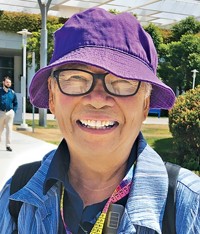Advertisement
Grab your lab coat. Let's get started
Welcome!
Welcome!
Create an account below to get 6 C&EN articles per month, receive newsletters and more - all free.
It seems this is your first time logging in online. Please enter the following information to continue.
As an ACS member you automatically get access to this site. All we need is few more details to create your reading experience.
Not you? Sign in with a different account.
Not you? Sign in with a different account.
ERROR 1
ERROR 1
ERROR 2
ERROR 2
ERROR 2
ERROR 2
ERROR 2
Password and Confirm password must match.
If you have an ACS member number, please enter it here so we can link this account to your membership. (optional)
ERROR 2
ACS values your privacy. By submitting your information, you are gaining access to C&EN and subscribing to our weekly newsletter. We use the information you provide to make your reading experience better, and we will never sell your data to third party members.
People
NMR And MRI Share Landmark Status
ACS honors magnetic resonance advances now considered indispensable in the lab and clinic
by Sophie L. Rovner
April 25, 2011
| A version of this story appeared in
Volume 89, Issue 17

The related developments of commercial nuclear magnetic resonance spectrometry (NMR) and magnetic resonance imaging (MRI)—which have revolutionized the practice of chemistry and medicine—were recently honored by the American Chemical Society as its 68th National Historic Chemical Landmark.
The landmark designation was marked with two ceremonies. MRI was honored with a celebration on March 11 at the State University of New York, Stony Brook. And on April 8, celebrants gathered at Agilent Technologies, a measurement company in Santa Clara, Calif., to recognize NMR advances.
Varian—whose scientific instrument company is now part of Agilent—introduced the A-60, the first commercially successful NMR spectrometer, in 1960. NMR was originally developed by physicists, but the affordability, reliability, and compact construction of the A-60 allowed chemists to use the technique to perform nondestructive analyses to elucidate molecular structures. What had previously taken chemists a month to determine could be done in hours, leading to NMR’s widespread use.

Stony Brook chemistry professor Paul C. Lauterbur used a Varian A-60 to take the science even further, demonstrating that NMR could generate multidimensional images. The discovery eventually led to the development of MRI, an important medical diagnostic tool for the noninvasive examination of body tissues such as the brain, heart, and other muscles. MRI scanning allows for early detection of cancer and other diseases. Lauterbur shared the 2003 Nobel Prize in Physiology or Medicine for his role in the development of MRI.
At the Stony Brook ceremony, ACS President Nancy B. Jackson presented the landmark plaque to John H. Marburger III, the university’s vice president for research. And Lauterbur’s widow, Joan Dawson, noted that the development of MRI originated in a “eureka” moment while Lauterbur was eating a hamburger at a local restaurant in 1971.
During the Agilent celebration, Abby Kennedy, chair of the ACS Santa Clara Valley Section, presented the landmark plaque to Nick Roelofs, president of Agilent Life Sciences Group.
ACS grants landmark status to seminal achievements in the history of chemical science and technology, including individual discoveries, bodies of work, resources, advances, or artifacts. Prospective landmarks can be nominated by ACS local sections, divisions, or committees. The landmarks committee reviews nominees, and the ACS Board of Directors approves them.
By recognizing landmark achievements of chemists, chemical engineers, and the chemical enterprise, the program is intended to enhance the public’s appreciation of the contributions of the chemical sciences and chemical engineering and to increase the sense of pride in their practitioners.





Join the conversation
Contact the reporter
Submit a Letter to the Editor for publication
Engage with us on Twitter